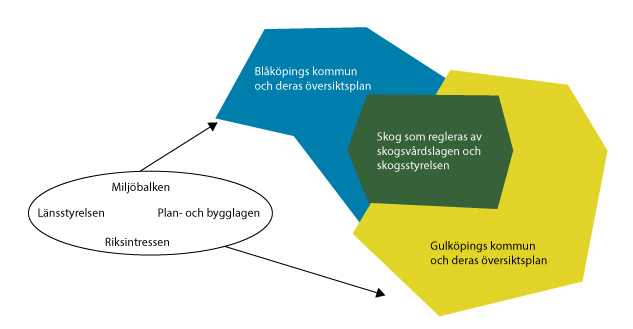An overarching plan that includes forest and municipal planning as well as other land-use interests is motivated, not least with thought to the possibility to understand and handle conflicts concerning the forest landscape.
Municipalities establish a municipal development plan accounting for how the land within the municipality will be used, as well as plans for its future use. The sketch plan is not legally binding, but rather functions more as a guiding principle for future planning. Sweden’s Planning and Building Act (Swe svenska plan- och bygglagen) states that it is a municipal matter to plan the use of land and water. Planning for the use of forest land is not a simple matter, however, as there are many interests and sections of law that concern the forest but are not related to each other, and lack a common umbrella and common goals to be taken into account.
A hive of different interests
In its planning, a municipality has an obligation to consider national interests such as nature values, culture heritage, recreation or economic sectors like electricity production, mineral extraction, the fishing and reindeer industries, and important infrastructure. Even if the municipalities retain their authority when it comes to planning, the State retains some control over certain aspects of the physical planning through the county administrative boards. Ongoing land use is also not to be affected by other, new interests like outdoor life, suburban expansion, or quarry activities. Forest management is regarded as ongoing land use, and has been considered so economically important that it is not clearly linked to municipal and regional planning. We should also mention ownership rights, which are to be set in relation to both written and unwritten laws, hunting rights, the Right of Public Access, and certifications. All these interests relate to varying degrees to different governance schemes and law provisions at different geographical levels. Different ambitions and various law provisions easily create problems, and the need for an overarching picture in which the forest landscape is part of a holistic, coordinated overall plan is tangible.
Forest planning in the municipal development plan
Sectors like mining, forest management and electricity production have laws and rules with a weak or unclear connection to the Environmental Code and the Planning and Building Act, which means that the municipality has a suboptimal overview of the physical planning and the need they always have for coordination and prioritization. The motivations for including forest land in the municipal development plan are many, especially considering that it is a resource of national importance that can also have great regional and local significance. Another argument is that this could increase the understanding of how forest land located near cities is used. The overall dilemma, however, is on a central level and in different law provisions that are unrelated to each other and lack a common umbrella and common goals. Another dilemma is how national ideas regarding governance should or can be implemented in the municipal planning process, and how the common interest is handled within different planning systems. A good overarching plan could be developed into a tool that could better coordinate different interests and territorial claims both today and in the future.
Facts
Olof Stjernström, Rein Ahas, Sabina Bergstén, Jeannette Eggers, Hando Hain, Svante Karlsson, E. Carina H. Keskitalo, Tomas Lämås, Örjan Pettersson, Per Sandström, Karin Öhman (2017), “Multi-level planning and conflicting interests in the forest landscape” in: Globalisation and Change in Forest Ownership and Forest Use. Natural Resource Management in Transition. Ed. by E. Carina H. Keskitalo. London: Palgrave Macmillan UK.
The study was conducted within the framework of PLURAL, a project financed by FORMAS “Starka forskningsmiljöer” 2012-2017.

